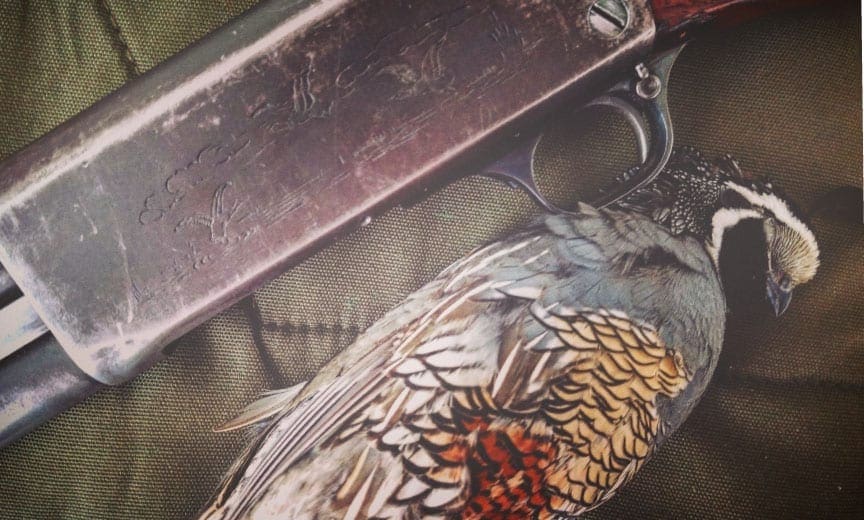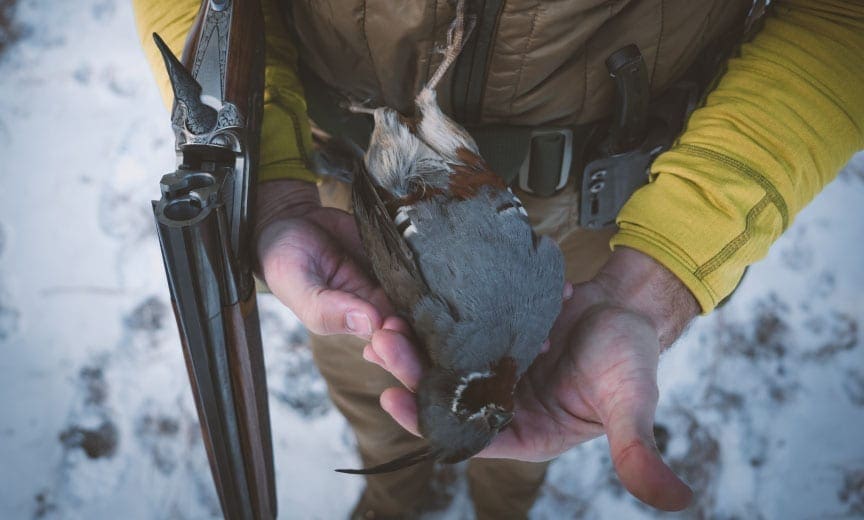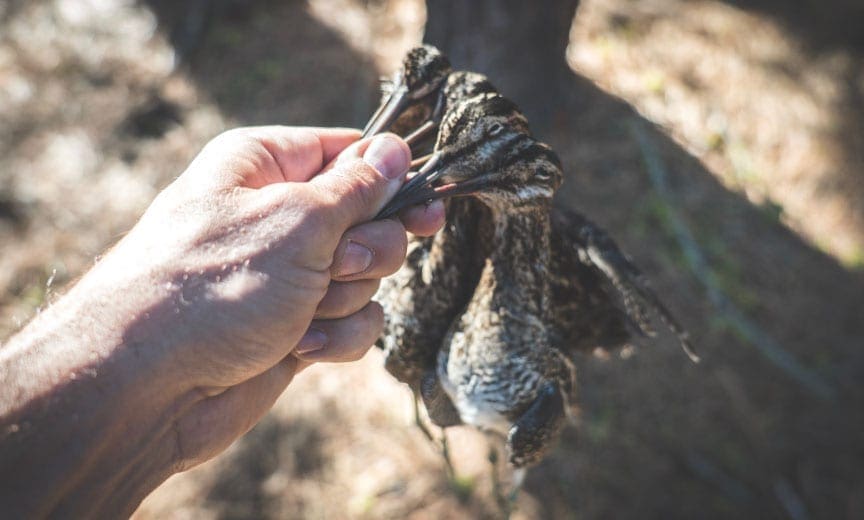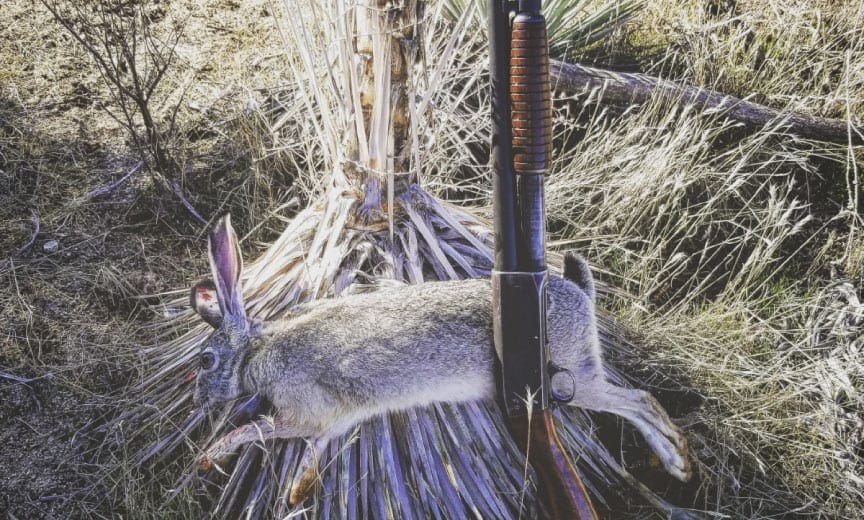Home » Hunting Rules, Licenses, and Seasons » Bird Hunting in California, Quail, Grouse and More
Bird Hunting in California, Quail, Grouse and More

Jorge Ramirez is a writer, artist, and upland hunter who…
Take a look at the amazing opportunities for upland and small game hunting in California.
When most people think of California they think of Hollywood, celebrities, beaches, and In-N-Out Burger. Away from all the hustle and bustle, gossipy-celebrity-scandals, anti-plastic straw laws, and smog-filled cities there are amazing wild areas within driving distance for the discriminating sportsman or sportswoman. Believe it or not, California was once the premiere destination for hunters just decades ago. I am sure you can place blame on overzealous “tree-huggers” and strict gun-control policies, but as it goes, these things are much more complicated to explain. California’s top spot on the list of places to hunt fell into decline and there are various opinions why, but California remains a sportsman’s paradise–even today! This is especially true for you upland hunters!
Study your map. Bust out your onX Hunt app. Find some BLM land or a national forest, because there is a lot of public land! The chances of getting into birds being here are very high. California is often overlooked as an upland hunting destination . . . and I am here to tell you: YOU ARE MISSING OUT!
Upland Species of California
California boasts one of the most eclectic lineups of upland birds in the nation. And if you plan and play your cards right, you might be able to come home with various species in your game vest, all on the same day! For instance, there are three different quail species in California that overlap in some areas. With dove and chukar nearby, can you say mixed game bag?
Please note that there are three different zones/seasons for quail. There is the Q1 Zone for the early mountain quail season in Northern and part of Central California. The early coastal season for all species is in the Q2 Zone and typically starts in late September. The main season begins in mid-October for all species in the remainder of the state, Q3 Zone, which includes Southern California.
California (Valley) Quail
The California or valley quail is, rightfully, California’s state bird. It is everywhere! Preferring green valleys and foothills, you can also find this game bird in the coastal regions, forests, mountains and semi-arid high deserts of California. North. Central. South. They’re everywhere. They are a hardy bird, but populations react positively after good rain seasons. Found in coveys from small to large (up to a hundred or more in wet seasons), their abundance offers hunters a lot of action throughout the season.

Gambel’s Quail
Gambel’s quail are similar in appearance to the California quail, though they lack the scaling pattern, have a bright copper head and cream bellies (males have a large circular black spot on their belly as well). Gambel’s tend to live in the southeast deserts of California and are known to be runners! They live in harsh areas where water is in little supply, getting much of their water intake from vegetation and insects that they eat. Their behavior and tendency to run, rather than fly, combined with the harsh environments they live in, make them a challenging quarry!
Mountain Quail
Mountain quail are the largest and probably the most secretive of all quail in America. The elusiveness of this species is magnified by their love of dense chaparral and manzanita thickets on mountain hillsides and shrubby foothills. Mountain quail are the only species of quail to migrate (albeit short distances, about 25-40 miles); they have home ranges in higher elevations during the spring and make their way downhill, below snow lines, during the winter. This species is most affected by seasonal rains and numbers plummet during dry seasons. They are known to not be more than a mile away from water sources. The rarity of this game bird makes them a worthy trophy that all upland hunters dream of encountering.

Pheasant
Introduced into California decades ago, small populations of ring-necked pheasant exist in Northern, Central and Southern California. These numbers are dwindling and you will be hard-pressed to find South Dakota type phez-action in California. But they are present! Although bag-limits are restrictive (currently 2-per day on the first two days of the season and 3 per day after) they offer a rare chance of hunting wild pheasant!
Chukar
Another introduced species, but far more successful than pheasant! Chukar found the hostile high deserts were just as homey as the craggy mountains of the Middle East and Southern Asia from which they originated. This is a bird that knows how to utilize its terrain to evade predators, like silly upland hunters! They are most common in the arid hills and mountains of southeastern California. Strap on your hiking boots and get ready for the suck!
Sooty and Ruffed Grouse
Grouse are another of California’s “trophy” game birds. Sooty grouse are common in the forested mountains of the Sierras and coastal forests of California. Ruffed grouse are a rarer species found mainly in the highest western corner of California. Both species have specific counties that are open to hunting, so if you have grouse on the brain when in California, be sure to do your homework!
Varieties of Dove
There are varieties of doves in California! The most plentiful, the mourning dove, are both migratory and resident birds. White-winged dove are also common in California. Daily bag limits are always generous for dove (15) and the bulk of harvesting occurs in California’s early season, which occurs September 1-15. A late season usually starts in November. Spotted and ringed turtle doves can be hunted during both seasons, as well. The invasive Eurasian collared dove can be hunted year-long with no bag limits, offering hunters exceptional hunting opportunities!
Snipe
Nope, snipe hunting is not a joke! Snipe are a wading bird, often found by shallow marshes or flooded agriculture fields. Waterfowl hunters will often spot these fascinating birds around the duck ponds scattered around the state. If an upland hunter is willing to get his or her boots wet, an opportunity to hunt a unique and challenging bird is not far behind.

Band-Tailed Pigeon
This rare game bird is closely related to the now-extinct passenger pigeon. Band-tailed pigeon are found up the entire coast of California; they also live in oak canyons, chaparral, and forested mountains where food sources are available. This game bird has been on the decline due to habitat loss and low reproductive rates. Despite declining numbers, there are short windows to hunt band-tailed pigeon, separated by Northern and Southern zones.
Ptarmigan
High in the Sierra Nevada mountains in California, you can find the smallest member of the grouse family, the ptarmigan! An introduced species, the white-tailed ptarmigan has thrived in the high altitudes of the Sierras over the past few decades. Expect to hike well past 10,000 feet to get into these rare birds.
Wild Turkey
Wild turkey are considered “upland game” in California. No tags. No drawing. You can hunt the elusive turkey in California with an Upland Hunting Stamp. California boasts two seasons, spring and fall. The Rio Grande wild turkey is the most wide spread of the subspecies, but parts of the state also host populations of Eastern wild turkey and Merriam’s. It is believed the south coast of the state holds an Eastern/Rio hybrid as well.
Come out during autumn when hunter competition is minimal, for either a gobbler or a hen, just in time for Thanksgiving! These sly birds often congregate near private land, but you can often catch them slipping onto public land.
Sage Grouse
Unfortunately, since 2017, there has not been an open season for California sage grouse due to declining numbers. They can be found in the sagebrush seas of Northeastern California. Loss of sagebrush habitat is one of the main culprits for declining populations today. If populations ever recover, expect it to be limited to a drawing for one bird.
Other Small Game Hunting Opportunities in California
Small game hunting and upland hunting go together like peas and carrots. Some may say they are one and the same. Though some upland hunters turn up their noses at shooting a rabbit or two, I often will take small game when out hunting birds. If you are up for a little diversity in your game bag, you will be pleased to know that California also offers great small-game hunting opportunities. And let’s not pretend that small game is not great table fare!
Cottontail Rabbit
Rabbits always seem to be there when I need them most, mostly when the birds are not cooperating! A cottontail rabbit or two in the bag always boosts morale and is also a great way to round out your mixed bag. Seasons generally start in mid-summer through winter.
Jackrabbit
Thanks to game meat advocates like Hank Shaw and Steve Rinella, the jackrabbit is seeing a bit of a resurgence on the dinner table. Plentiful and widespread, jackrabbits can be hunted year-long and will often help perk up spirits when there is a lull in the bird action. These hares can get massive and a single mature “buck” is more than enough to feed a couple of hungry hunters. This is great news because hunters can take advantage of year-long seasons, with no bag-limits.

Squirrel
If you like craning your neck up scanning Ponderosa-pines and oaks for furry-tailed grey squirrel, you are in luck! An often-untapped small game species, squirrel hunting opportunities are readily available in much of the state and there is little hunter pressure. Currently, the southern zone does not have an open season, but the majority of the state typically has a season that begins in September and ends in late winter. Ground squirrels are not considered a game mammal and can be hunted year-long and throughout the entire state with no bag-limits.
Check here for all current upland-game regulations and bag limits and for small game here.
Licensing
All California residents must have resided in California at least six consecutive months and must have passed a mandatory “Hunter Safety” course before purchasing a license. If you are planning to hunt upland birds, you will also need to purchase a separate “Upland Game” stamp.
Junior hunters (under 18) may purchase a reduced-cost Junior Hunter License and do not need to buy an Upland Game stamp.
All Non-Resident (Out of State) hunters are required to have a previous Out of State hunting license no more than 2 years old or proof of current hunter safety course certificate. All Non-Resident hunters planning to hunt upland game are required to purchase an Upland Game stamp. Non-Resident Junior hunters may purchase a Junior Hunter License and do not need to buy an Upland Game stamp.
Check here for all current license and stamp fees.
What’s Good about Hunting Califonia?
California offers unique upland hunting opportunities unlike anywhere in the USA. If you plan carefully, you can hunt several species at once! There are areas where you can hunt mountain, valley and Gambel’s quail all at once and maybe even some chukar, for example.
California is a beautiful state. That cannot be argued. You can be on the sunny beach and take an hour’s drive up the road into tall pines and mountains. You can spend a morning out hunting wild game and be back in time for a night out in the posh clubs. Bring your family. Drop them off at Disneyland and drive out to your nearest public lands! Make a family vacation out of it!
Although public land access is always at risk, California still has very accessible areas to hunt upland game. Upland birds like quail and dove are plentiful on public land! Like many Western states, California is fortunate enough to still hold onto vast amounts of public land. About 45 percent of the state is public land. Consider that much of this land has birds of some kind in it, chances that you are going to get into some birds are pretty high! If people ever tell you there is no place to hunt, it’s a lie or they are just too lazy to drive an hour from Los Angeles.
The weather during hunting season is mild when compared to other states back East, especially in Southern California. So, if you need a break from the cold and gloomy eastern states but still want to hunt some birds, come out to sunny California!
Despite drought and dry seasons, most of the resident upland birds in California are built for the climate and lack of precipitation. Most quail are especially hardy birds and will carry over into the next season with average numbers even with minimal precipitation. Years with great rainfall, however, will promote better chick conditions (more water = more weeds = more bugs = more quail chicks) and that just means better hunting! When it rains here, it pours! Those are the best years to hunt here.
What are the Challenges?
Currently, California is the first state to do a complete lead-ammo ban. This started out as a multi-phase process in 2015 and went into full effect by July 2019. Hunters in California must use lead alternatives like steel, tungsten or my favorite, bismuth. As the market adjusts, hunters should be sure to purchase non-lead ammo well before the season starts to avoid ammo shortages at your favorite retailer. Non-Resident hunters must keep in mind that non-lead alternatives must be purchased prior to coming to hunt in California.
California also observes some of the strictest gun and ammo laws in the nation. A new law requiring background checks for ammo has slowed the purchasing process for some hunters. Non-residents may find it even harder to buy ammo in the state. Unless you plan to get a COE (Certificate of Eligibility), which requires a Live Scan and must be renewed annually, non-resident hunters should just bring enough of their own ammo. It is completely legal for a non-resident hunters to transport both firearms and ammo across state lines into California for hunting.
As mentioned, there is an abundance of public land to hunt on in California. Unfortunately, about 38,000 acres of this land is landlocked by privately owned boundaries. This is land that can be rightfully hunted and enjoyed by the public but cannot be accessed!
In the winter of 2018/2019, California saw record rainfall, pulling it out of a 100-plus-year drought. Despite that, California is still a dry place and we are slowly regressing back into drought. Wildlife, including durable upland game like quail, are affected by (lack of) rainfall and numbers will plummet during the driest of the seasons. Birds may be harder to find, and you should not expect to get limits during these times.
I was born and raised in California. I was always fortunate enough to know this was a great state to hunt in. I chuckle when people disregard California as a state worth stopping at. It is easy to get caught up with the stereotypes and myths. I am here to tell you that California is worth your attention and a trip out to our uplands! The state of California may rub you the wrong way when it comes to its politics, traffic, and annoying celebrities. Ignore all that. Don’t focus on the negative. Look at what California has to offer. The weather. The sunsets. A drive into the wilderness, out chasing wild birds, will only prove that California is so much more than you think. It’s worth the visit. I’d bet on it. Bring your shotgun, plenty of shells, and a fashionable pair of sunglasses . . . because it’s looking bright out here.
Jorge Ramirez is a writer, artist, and upland hunter who was born and raised in Southern California. His passion for upland hunting led to the creation of his blog/website, UplandJitsu: The Art of Upland Hunting. His blog primarily consists of articles dedicated to the traditions of quail hunting with an emphasis on introducing new hunters to DIY public land hunts, without a dog. He currently resides in Long Beach and hunts in the nearby National Forests for upland game.




Very Good information! Thank You Jorge!
Thanks for that read bro! 1st year hunting and started with dove around Palm Springs with a buddy and his family! This article is a gem! Can’t wait to learn more to pass onto my kids!
Any birds around palm springs area? Thanks
Definitely a lot of birds in and around Palm Springs area… the further you get from the city limits, the better, as more public land opportunities open up. I typically hunt about an hour east of the Palm Springs area and get into some great Gambel’s quail country!
Thank you for the articles. I was born and raised in Southern California. Started upland hunting at the age of 53. This will be my sixth year in the uplands. I have not been very successful, but have learned a great deal. I am addicted and plan on hunting until I can’t walk anymore. I am hoping this year will be my best year.